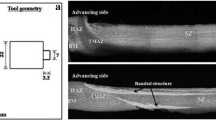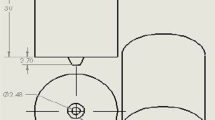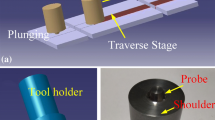Abstract
W–25%Re tool was used to friction stir weld ASTM A516-70 steel. This paper presents the results of studying the effects of rotational speed on tool reaction loads, tool wear, weld defects, and weld microstructure. The measured tool axial forces profile were found to be strongly coupled with the weld surface features. At high values of rotational speed, weld microstructure examinations revealed a wide heat-affected zone, coarse grains, and partial dissolving of ferrite and pearlite. These are attributed to the excessive heat generation at high levels of rotational speeds. Stir zone grain refinement occurred at all levels of rotational speeds under investigation, with the finest grains occurring at lower values of the rotational speeds. W–25%Re tool demonstrated excellent wear resistance at low rotational speed. However, at high values of rotational speeds fluctuating loads and high heat input resulted in excessive wear of the tool. Greater amount of wear took place at the tool shoulder, which experienced 50% reduction in the tool shoulder shank. Moreover, elemental diffusion of tungsten occurred into the weld and was found to increase with the increase in tool rotational speed.
Similar content being viewed by others
References
Thomas, W.M.; Nicholas, E.D.; Needhan, J.C.; Murch, M.G.; Temple-Smith, P.; Dawes, C.J.: International patent application PCT/GB92/02203 and GB patent application 9125978.8. UK Patent Office, London, 6 (1991)
Prabhu, S.; Shettigar, A.K.; Rao, K.; Rao, S.; Herbert, M.: Influence of welding process parameters on microstructure and mechanical properties of friction stir welded aluminium matrix composite. Mater. Sci. Forum 880, 50–53 (2017)
Mishra, R.S.; De, P.S.; Kumar, N.: Friction Stir Welding and Processing, Science and Engineering. Springer, London (2014)
Fènoël, M.A.; Simar, A.: A review about friction stir welding of metal matrix composites. Mater. Charact. 120, 1–17 (2016)
Park, S.H.C.; Sato, Y.S.; Kokawa, H.; Okamoto, K.; Hirano, S.; Inagaki, M.: Boride formation induced by pcBN tool wear in friction-stir-welded stainless steels. Metall. Mater. Trans. A 40(3), 625–636 (2009)
Rai, R.; De, A.; Bhadeshia, H.K.D.H.; DebRoy, T.: Review: friction stir welding tools. Sci. Technol. Weld. Join. 16(4), 325–342 (2011)
Shirazi, H.; Kheirandish, S.; Safarkhanian, M.A.: Effect of process parameters on the macrostructure and defect formation in friction stir lap welding of AA5456 aluminum alloy. Measurement 76, 62–69 (2015)
Thompson, B.: Tungsten-based tool material development for the friction stir welding of hard metals. In: Friction Stir Welding and Processing VI, pp. 105–112
Buffa, G.; Fratini, L.; Micari, F.; Settineri, L.: On the choice of tool material in friction stir welding of titanium alloys. In: Transaction of North American Manufacturing Research Conference of SME June 4–8, 2012 Notre Dame, pp. 785–794. Indiana, USA (2012)
Iqbal, Z.; Saheb, N.; Shuaib, A.R.: W–25%Re–HfC composite materials for pin tool material applications: synthesis and consolidation. J. Alloys Compd. 674, 189–199 (2016)
Iqbal, Z.; Merah, N.; Saheb, N.; Shuaib, A.R.; Aqeeli, A.N.: Investigation of wear characteristics of spark plasma sintered W–25wt%Re alloy and W–25wt%Re–3.2wt%HfC composite. Tribol. Int. 116, 129–137 (2017)
Hsieh, M.J.; Chiou, Y.C.; Lee, R.T.: Friction stir spot welding of low-carbon steel using an assembly-embedded rod tool. J. Mater. Process. Technol. 224, 149–155 (2015)
Lienert, T.J.; Stellwag Jr., W.L.; Grimmett, B.B.; Warke, R.W.: Friction stir welding studies on mild steel. Weld. J. N. Y. 82(1), 1–9 (2003)
Bilgin, M.B.; Meran, C.: The effect of tool rotational and traverse speed on friction stir weldability of AISI 430 ferritic stainless steels. Mater. Des. 33, 376–383 (2012)
Barnes, S.J.; Bhatti, A.R.; Steuwer, A.; Johnson, R.; Altenkirch, J.; Withers, P.J.: Friction stir welding in HSLA-65 steel: Part I. Influence of weld speed and tool material on microstructural development. Metall. Mater. Trans. A 43(7), 2342–2355 (2012)
Schmidt, H.; Hattel, J.; Wert, J.: An analytical model for the heat generation in friction stir welding. Modell. Simul. Mater. Sci. Eng. 12(1), 143 (2003)
Al-Badour, F.A.; Merah, N.; Shuaib, A.; Bazoune, A.: Experimental investigation of friction stir seal welding of tube-tubesheet joints. J. Press. Vessel Technol. 137(1), 011402 (2015)
Shuaib, A.R.; Al-Badour, F.; Merah, N.: Friction stir seal welding (FSSW) tube-tubesheet joints made of steel. In: ASME 2015 Pressure Vessels and Piping Conference, pp. V06BT06A005–V06BT06A005. American Society of Mechanical Engineers (2015)
European Standard: Friction Stir Welding Aluminium Part 1: Vocabulary (ISO 25239–1:2011). European Committee for Standardization, CEN (2011)
Zhang, Z.; Zhang, H.W.: Solid mechanics-based Eulerian model of friction stir welding. Int. J. Adv. Manuf. Technol. 72(9–12), 1647–1653 (2014)
Bastier, A.; Maitournam, M.H.; Van Dang, K.; Roger, F.: Steady state thermomechanical modelling of friction stir welding. Sci. Technol. Weld. Join. 11(3), 278–288 (2006)
Jun, C.K.; Hoch, M.: Thermal conductivity of tantalum, tungsten, rhenium, tantalum-10 tungsten, t (111), t (222), tungsten-25 rhenium alloys in the temperature range 1500–2800 k. Cincinnati Univ of Materials Science Program (1966)
Wade, M.; Reynolds, A.P.: Friction stir weld nugget temperature asymmetry. Sci. Technol. Weld. Join. 15, 64–39 (2013)
Al-Badour, F.; Merah, N.; Shuaib, A.; Bazoune, A.: Thermo-mechanical finite element model of friction stir welding of dissimilar alloys. Int. J. Adv. Manuf. Technol. 72(5–8), 607–617 (2014)
Linnert, G.E.: Welding Metallurgy, Carbon and Alloy Steels, Vol. 1. Fundamentals. American Welding Society, Welding Metallurgy, Carbon and Alloy Steels, 1, 940 (1994)
Hughes, K.E.; Nair, K.D.; Sellars, C.M.: Temperature and flow stress during the hot extrusion of steel. Met. Technol. 1, 161–169 (2013)
ASTM E384-17: Standard Test Method for Microindentation Hardness of Materials. ASTM International, West Conshohocken. www.astm.org (2017)
Pradeep, A.; Muthukumaran, S.: Two modes of metal transfer phenomenon in friction stir welding of low alloy steel plates. In: Proceedings of the 1st International Joint Symposium on Joining and Welding: Osaka, Japan, 6–8 Nov 2013, p. 305. Woodhead Publishing (2014)
Author information
Authors and Affiliations
Corresponding author
Rights and permissions
About this article
Cite this article
Iqbal, Z., Bazoune, A., Al-Badour, F. et al. Effect of Tool Rotational Speed on Friction Stir Welding of ASTM A516-70 Steel Using W–25%Re Alloy Tool. Arab J Sci Eng 44, 1233–1242 (2019). https://doi.org/10.1007/s13369-018-3452-3
Received:
Accepted:
Published:
Issue Date:
DOI: https://doi.org/10.1007/s13369-018-3452-3




